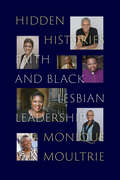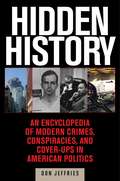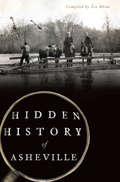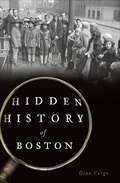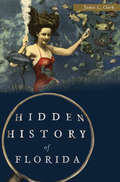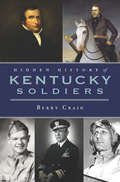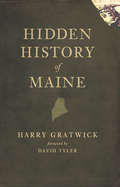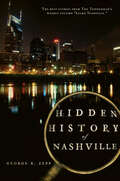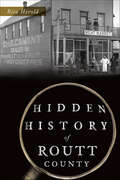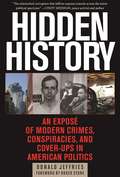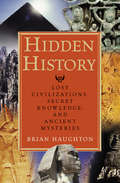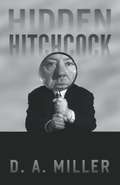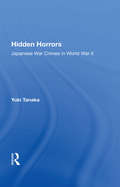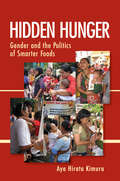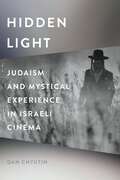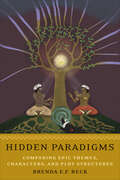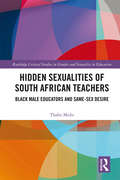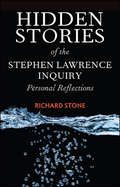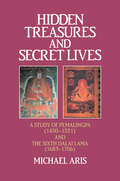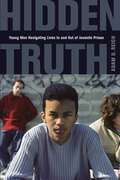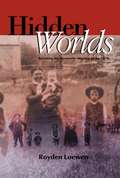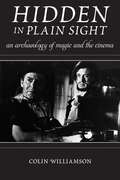- Table View
- List View
Hidden Histories: Faith and Black Lesbian Leadership
by Monique MoultrieIn Hidden Histories, Monique Moultrie collects oral histories of Black lesbian religious leaders in the United States to show how their authenticity, social justice awareness, spirituality, and collaborative leadership make them models of womanist ethical leadership. By examining their life histories, Moultrie frames queer storytelling as an ethical act of resistance to the racism, sexism, and heterosexism these women experience. She outlines these women’s collaborative, intergenerational, and leadership styles, and their concerns for the greater good and holistic well-being of humanity and the earth. She also demonstrates how their ethos of social justice activism extends beyond LGBTQ and racialized communities and provides other models of religious and community leadership. Addressing the invisibility of Black lesbian religious leaders in scholarship and public discourse, Moultrie revises modern understandings of how race, gender, and sexual identities interact with religious practice and organization in the twenty-first century.
Hidden History
by Donald JeffriesThe US government has spent half the time covering up conspiracies as it has spent helping the American people. In Hidden History, you will see the amount of effort over the past fifty years that our government has dedicated to lying and covering up the truth to the world.Starting with the assassination of President John F. Kennedy, Don Jeffries chronicles a wide variety of issues that have plagued our country's history. Whether it's the assassinations of MLK and RFK, Iran-Contra, the Oklahoma City bombing, TWA Flight 800, voting fraud, or 9/11, every major disaster or war that we've witnessed has somehow been distorted by those who are supposed to be protecting us.Jeffries also delves into extensive research on the death of John F. Kennedy Jr., and you'll be shocked by what he finds out.So whether you've only heard bits and pieces of these stories or have read several books on the topics, Hidden History is the book that belongs in every conspiracy theorist's library, as the information included in this encyclopedia has never been collected together in any other published work available. So sit down, strap in, and get ready to be shocked and awed by how much has been hidden from you by our government over the past fifty years.
Hidden History of Asheville (Hidden History)
by Zoe RhineThe milestones of Asheville's long history are well known to locals, but so many interesting stories are all but forgotten. Thankfully, the staff and volunteers of the North Carolina Room at Pack Memorial Library have unearthed the best of those hidden tales. Meet daredevil aviatrix Uva Shipman and Tempie Avery, who went from slavery to respected nurse and citizen. Learn the poignant tale behind the sad death of former mayor Gallatin Roberts and uncover the parts of old Asheville lost to the wrecking ball. These and many more historic episodes come to life in this collection compiled by North Carolina Room librarian Zoe Rhine.
Hidden History of Boston: History Through Architecture (Hidden History)
by Dina VargoQuirky and little-known true stories of one of America&’s most historic cities. Boston may play a big role in American history textbooks, but it also has quite a bit of forgotten past. For example, during the colonial era, riotous mobs celebrated their hatred of the pope in an annual celebration called Pope&’s Night. In 1659, Christmas was made illegal, a ban by the Puritans that remained in effect for twenty-two years. William Monroe Trotter published the Boston Guardian, an independent African American newspaper, and was a beacon of civil rights activism at the turn of the century. And in more recent times, a centuries-long turf war played out on the streets of quiet Chinatown, ending in the massacre of five men in a back alley in 1991. Author and historian Dina Vargo shines a light into the cobwebbed corners of Boston&’s hidden history in this riveting read, complete with illustrations.
Hidden History of Florida (Hidden History)
by James C. ClarkA Florida historian uncovers strange but true tales of The Sunshine State from the 16th century arrival of Spanish ships to the antics of modern politics. From Key West to the Redneck Riviera, Florida has a history as colorful as its landscape and as diverse as its residents. But beneath the famous legends of Florida&’s storied past are intriguing tales that don&’t appear in the popular guides or history books. In Hidden History of Florida, author James Clark shines a light on some of the most fascinating untold stories of this unique Southern State. Here you will learn about then heartbroken senator who entered a mental institution over unrequited love for an heiress; the thousands of British pilots who trained in flight schools across the state; and the dark, true story of Pocahontas—and how it is linked with America&’s "first barbecue."
Hidden History of Kentucky Soldiers (Hidden History Ser.)
by Berry CraigA look at the lesser-known heroics of Kentucky soldiers, from the French and Indian War to World War II. Daniel Boone is celebrated as a Kentucky frontiersman, but what about his service in the French and Indian War? Custer&’s Last Stand in the Great Sioux War is legendary, but few remember Custer&’s &“next-to-last-stand&” in Elizabethtown, where he was sent to suppress the Ku Klux Klan and hunt down moonshiners just before heading to the Montana Territory and into history. Join Kentucky historian Berry Craig as he unearths the forgotten heroics of Kentucky soldiers, beginning with the French and Indian War and ending with World War II. Featuring tales of warriors from a diverse range of backgrounds, Hidden History of Kentucky Soldiers honors generations of Kentuckians who put their lives on the line for their country.
Hidden History of Maine (Hidden History)
by Harry GratwickDiscover 400 years of New England history you won&’t find in guidebooks in this collection of true stories and colorful characters from The Pine Tree State. Maine wouldn&’t be the magical place it is today without the contributions of little-known individuals whose inspiring and adventuresome lives make up the story of Maine's "hidden history." Journalist and Maine historian Harry Gratwick presents vividly detailed portraits of these Mainers, from the controversial missionary Sebastien Rale to Woolwich native William Phips, whose seafaring attacks against French Canada earned him the first governorship of the Massachusetts Bay Colony. Gratwick also profiles inventors such as Robert Benjamin Lewis, an African American from Gardiner who patented a hair growth product in the 1830s, and Margaret Knight, a York native who defied nineteenth-century sexism to earn the nickname "the female Edison." From soprano Lillian Nordica, who left Farmington to become the most glamorous American opera singer of her day, to slugger George "Piano Legs" Gore, the only Mainer to ever win a Major League Baseball batting championship, Hidden History of Maine reveals the men and women who made history without making it into history books.
Hidden History of Nashville: The Best Stories From The Tennessean's Weekly Column "Learn Nashville" (Hidden History)
by George R ZeppThis collection uncovers the fascinating past of Tennessee&’s legendary Music City from true tall tales to larger than life characters and much more. Perched on the banks of the Cumberland River, Nashville is best known for its role in the civil rights movement, world-class education and, of course, country music. In this unique collection of columns written for The Tennessean, journalist and longtime Tennessee native George Zepp illuminates a less familiar side of the city&’s history. Here, readers will learn the secrets of Timothy Demonbreun, one of the city's first residents, who lived with his family in a cliff-top cave; Cortelia Clark, the blind bluesman who continued to perform on street corners after winning a Grammy award; and Nashville's own Cinderella story, which involved legendary radio personality Edgar Bergen and his ventriloquist protegee. Based on questions from readers across the nation, these little-known tales abound with Music City mystery and charm.
Hidden History of Routt County (Hidden History)
by Rita HeroldSettling Routt County was never easy or safe. Fugitives used the undeveloped landscape as an "outlaw trail" to evade authorities. The inexorable Harry Tracy managed three jailbreaks before being killed by a posse. Conversely, many of the first families left entrepreneurial legacies. Widowed Alice Bartz sold the family homestead to start the Bartz Hotel in her Steamboat Springs' bakery and house, serving three meals a day to locals and guests. Others families, like the Nays and the Laughlins, were able to cut hay and raise enough livestock to pass the land down to future generations. Native author Rita Herold preserves oral histories and nearly forgotten episodes of the county's past.
Hidden History: An Exposé of Modern Crimes, Conspiracies, and Cover-Ups in American Politics
by Roger Stone Donald JeffriesThe US government has spent as much time covering up conspiracies as it has helping the American people. In Hidden History, you will see the amount of effort that our government has dedicated over the past fifty years to lying and covering up the truth to the world.Starting with the assassination of President John F. Kennedy, Don Jeffries chronicles a wide variety of issues that have plagued our country's history. Whether it is the assassinations of MLK and RFK, Iran-Contra, the Oklahoma City bombing, TWA Flight 800, voting fraud, or 9/11, every major disaster or war that we've sitnessed has somehow been distorted by those who are supposed to be protecting us. Jeffries also delves into extensive research on the death of John F. Kennedy, Jr. - and what he finds will shock you.So whether you've only heard bits and pieces of these stories or you've read several books on the topics, Hidden History is the book that belongs in every conspiracy theorist's library, as the information included here has never been collected together in any other published work available. So sit down, strap in, and get ready to be shocked and awed by how much has been hidden by our government over the past fifty years. Updated for 2016, this version features a new introduction by political insider Roger Stone.
Hidden History: Lost Civilizations, Secret Knowledge, and Ancient Mysteries
by Brian HaughtonAn archaeologist explores history&’s most fascinating enigmas, from the ancient Druids to the mysteries of the Mayan calendar and the lost city of Atlantis. Across thousands of years of history, so-called lost civilizations still speak to us through their artifacts and architecture. In Hidden History, archaeologist Brian Haughton fills the gap between archaeology and alternative history using the latest available data and a common sense, open-minded approach. Divided into three sections, this expertly researched volume shares the secrets of Mysterious Places, Unexplained Artifacts, and Enigmatic People. Haughton introduces readers to the greatest mysteries of the ancient world, from the labyrinthine palace of Knossos on Crete to the pyramids of Egypt, the remote jungle temples of Peru, and the megalithic mystery of Stonehenge. But he also goes further to explore historical puzzles like the Coso Artifact, the possibility of ancient flight, and the Voynich Manuscript, as well as mysterious peoples from the Magi and the Druids to the Knights Templar and the Green Children. With more than 50 photographs and illustrations, this is the ideal reference work for those interested in the archaeology of these great enigmas.
Hidden Hitchcock
by D. A. MillerNo filmmaker has more successfully courted mass-audience understanding than Alfred Hitchcock, and none has been studied more intensively by scholars. In Hidden Hitchcock, D. A. Miller does what seems impossible: he discovers what has remained unseen in Hitchcock's movies, a secret style that imbues his films with a radical duplicity. Focusing on three films--Strangers on a Train, Rope, and The Wrong Man--Miller shows how Hitchcock anticipates, even demands a "Too-Close Viewer." Dwelling within us all and vigilant even when everything appears to be in good order, this Too-Close Viewer attempts to see more than the director points out, to expand the space of the film and the duration of the viewing experience. And, thanks to Hidden Hitchcock, that obsessive attention is rewarded. In Hitchcock's visual puns, his so-called continuity errors, and his hidden appearances (not to be confused with his cameos), Miller finds wellsprings of enigma. Hidden Hitchcock is a revelatory work that not only shows how little we know this best known of filmmakers, but also how near such too-close viewing comes to cinephilic madness.
Hidden Horrors: Japanese War Crimes In World War Ii (Asian Voices Ser.)
by Yuki TanakaThis book documents for the first time previously hidden Japanese atrocities in World War II, including cannibalism; the slaughter and starvation of prisoners of war; the rape, enforced prostitution, and murder of noncombatants; and biological warfare experiments. The author describes how desperate Japanese soldiers consumed the flesh of their own comrades killed in fighting as well as that of Australians, Pakistanis, and Indians. Another chapter traces the fate of 65 shipwrecked Australian nurses and British soldiers who were shot or stabbed to death by Japanese soldiers. Thirty-two other nurses, who landed on another island, were captured and sent to Sumatra to become “comfort women‗prostitutes for Japanese soldiers. Tanaka recounts how thousands of Australian and British POWs died in the infamous Sandakan camp in the Borneo jungle in 1945. Those who survived were forced to endure a tortuous 160-mile march on which anyone who dropped out of line was immediately shot. Only six escapees lived to tell the tale. Based on exhaustive research in previously closed archives, this book represents a landmark analysis of Japanese war crimes. The author explores individual atrocities in their broader social, psychological, and institutional milieu and places Japanese behavior during the war in the broader context of the dehumanization of men at war—without denying individual and national responsibility.
Hidden Hunger: Gender and the Politics of Smarter Foods
by Aya Hirata KimuraFor decades, NGOs targeting world hunger focused on ensuring that adequate quantities of food were being sent to those in need. In the 1990s, the international food policy community turned its focus to the "hidden hunger" of micronutrient deficiencies, a problem that resulted in two scientific solutions: fortification, the addition of nutrients to processed foods, and biofortification, the modification of crops to produce more nutritious yields. This hidden hunger was presented as a scientific problem to be solved by "experts" and scientifically engineered smart foods rather than through local knowledge, which was deemed unscientific and, hence, irrelevant. In Hidden Hunger, Aya Hirata Kimura explores this recent emphasis on micronutrients and smart foods within the international development community and, in particular, how the voices of women were silenced despite their expertise in food purchasing and preparation. Kimura grounds her analysis in case studies of attempts to enrich and market three basic foods-rice, wheat flour, and baby food-in Indonesia. She shows the power of nutritionism and how its technical focus enhanced the power of corporations as a government partner while restricting public participation in the making of policy for public health and food. She also analyzes the role of advertising to promote fortified foodstuffs and traces the history of Golden Rice, a crop genetically engineered to alleviate vitamin A deficiencies. Situating the recent turn to smart food in Indonesia and elsewhere as part of a long history of technical attempts to solve the Third World food problem, Kimura deftly analyzes the intersection of scientific expertise, market forces, and gendered knowledge to illuminate how hidden hunger ultimately defined women as victims rather than as active agents.
Hidden Light: Judaism and Mystical Experience in Israeli Cinema (Contemporary Approaches to Film and Media Series)
by Dan ChyutinOver the past several decades, the prevailing attitude toward Judaism in Israeli society has undergone a meaningful shift; where the national ethos had once deemed Judaic traditions a vestige of an arcane past incompatible with the culture of a modern state, there is now greater acceptance of these traditions by a sizeable part of Israeli society. Author Dan Chyutin reveals this trend through a parallel shift toward acceptance and celebration of Judaic identity and lifestyle in modern Israeli cinema. Hidden Light explores the Judaic turn in contemporary Israeli filmmaking for what it can tell us about Israel’s cultural landscape, as well as about the cinematic medium in general. Chyutin points to the ambivalence of films which incorporate Judaism into Israel’s secular ethos; concurrently, he foregrounds the films' attempt to overcome this ambivalence through reference to and activation of experiences of transcendence and unity, made popular by New Age–inflected understandings of Jewish mystical thought. By virtue of this exploration, Judaic-themed Israeli cinema emerges as a crucial example of how film’s particular form of "magic" may be exploited for the purpose of affecting mystical states in the audience.
Hidden Paradigms: Comparing Epic Themes, Characters, and Plot Structures
by Brenda E.F. BeckUnderstanding an epic story’s key belief patterns can reveal community-level values, the nature of familial bonds, and how divine and human concerns jockey for power and influence. These foundational motifs remain understudied as they relate to South Asian folk legends, but are nonetheless crucial in shaping the values exemplified by such stories’ central heroes and heroines. In Hidden Paradigms, anthropologist Brenda E.F. Beck describes The Legend of Ponnivala, an oral epic from rural South India. Recorded in 1965, this story was sung to a group of village enthusiasts by a respected pair of local bards. This grand legend took more than thirty-eight hours to complete over eighteen nights. Bringing this unique example of Tamil culture to the attention of an international audience, Beck compares this virtually unknown South Indian epic to five other culturally significant works – the Ojibwa Nanabush cycle, the Mahabharata, an Icelandic Saga, the Bible, and the Epic of Gilgamesh – establishing this foundational Tamil story as one that engages with the same universal human struggles and themes present throughout the world. Copiously illustrated, Hidden Paradigms provides a fresh example of the power of comparative thinking, offering a humanistic complement to scientific reasoning.
Hidden Sexualities of South African Teachers: Black Male Educators and Same-sex Desire (Routledge Critical Studies in Gender and Sexuality in Education)
by Thabo MsibiSouth Africa remains a global leader in the legislative protection of individuals who engage in same-sex relations, and is the only country in Africa where the rights of these individuals are explicitly recognized and protected by the constitution. Yet South Africa’s identities are still contested and evolving, particularly for same-sex desiring teachers – many are forced to locate their sexualities privately for fear of being ostracized, bullied or losing their jobs, resulting in the miseducation of young people in schools. This volume reveals the various ways in which black South African male teachers construct their sexual and professional identities, how they accommodate structural dictates while simultaneously resisting them, and the effect this has on students. Presenting the day-to-day experiences of eight same-sex desiring teachers within repressive contexts, this volume challenges the Western origins and assumptions of queer theory, particularly its inability to confront communal forms of social organizing and its focus on individual agency. It asks for more socially responsive theorizing that takes into account the role played by location, race, class, gender and sexual identification within South African and international contexts.
Hidden Sorrow, Lasting Joy: The Forgotten Women of the Persecuted Church
by Anneke CompanjenStories of women persecuted for their faith around the world. Includes resources for helping.
Hidden Stories of the Stephen Lawrence Inquiry: Personal Reflections
by Richard StoneYoung people who come into contact with police officers on the streets today have little idea of the significance of the stabbing to death of Stephen Lawrence in a racist attack in 1993. Only their parents or grandparents remember the daily exposures of police incompetence and indirect racism which were given high profile in the media for six months. The repercussions of the case are still ongoing with the long overdue conviction in 2012 of two of the original suspects, and in the same year a number of racist assaults by police. This accessible and engaging book includes analysis of hitherto inaccessible transcripts. These dramatically show how the Inquiry was undermined to the point of failure to produce the desired results. Dr Stone also discusses contemporary issues and the relevance of the Inquiry today. This paperback edition is updated with a new Afterword, including revelations about police surveillance on members of the public who attended the Lawrence Inquiry, Dr Stone’s meeting with Mark Ellison QC prior to the release of his report on possible corruption and the role of undercover policing in the Stephen Lawrence case, and proposals for action on implementation of the agenda set by the Lawrence Inquiry. Hard-hitting and full of insightful detail, this book makes essential reading for academics, students, researchers and anyone interested in institutional racism, particularly in the police.
Hidden Treasures & Secret Lives: A Study Of Pemalingpa (1450-1521) And The Sixth Dalai Lama (1683-1706)
by ArisFirst published in 1989. Routledge is an imprint of Taylor & Francis, an informa company.
Hidden Truth: Young Men Navigating Lives In and Out of Juvenile Prison
by Adam ReichHidden Truth takes the reader inside a Rhode Island juvenile prison to explore broader questions of how poor, disenfranchised young men come to terms with masculinity and identity. Adam D. Reich, who worked with inmates to produce a newspaper, writes vividly and memorably about the young men he came to know, and in the process extends theories of masculinity, crime, and social reproduction into a provocative new paradigm. Reich suggests that young men's participation in crime constitutes a game through which they achieve "outsider masculinity." Once in prison these same youths are forced to reconcile their criminal practices with a new game and new "insider masculinity" enforced by guards and administrators.
Hidden Wisdom: Secrets of the Western Esoteric Tradition
by Tim Wallace-Murphy“The best book about the secret tradition I’ve read for many years. Tim Wallace-Murphy writes with style, passion and truth. A magnificent achievement.” —Graham Hancock, New York Times–bestselling author of Fingerprints of the GodsFrom Egyptian mythology to Jewish mysticism, Rome and Greece to the druids and the gnostics, Tim Wallace-Murphy exposes a fascinating lineage of hidden mysteries and secret societies, continuing through the Templars, Rosicrucians, and Freemasons to our modern visionaries. This hidden stream of spirituality and that of sacred knowledge are inseparably entwined to form the single most important continuous strand in the entire Western esoteric tradition.This tradition exerted a seminal influence on the thinking of the builders of the great cathedrals/ leading teachers in ecclesiastical schools/ philosophers/ playwrights/ poets such as Shakespeare, Goethe, Blake, and W. B. Yeats/ and on artists and Renaissance giants such as Leonardo da Vinci and Michelangelo. It is also the root from which sprang alchemy and modern science.Now, as more people are looking to find information on the alternatives to dominant religions and dogmas that have told us what to think and how to behave, as faith has been questioned by religious scandals, economic meltdowns, and an increasingly sick planet Earth, Wallace-Murphy reveals the secrets of the masters, including invaluable spiritual insights into everyday life that have been hidden throughout the ages. He shows us who kept this spiritual tradition alive despite appalling persecution, so that we in the twenty-first century might benefit from its accumulated fruits and ennoble our lives.Hidden Wisdom will be of immense interest to readers of the number-one bestseller The Lost Symbol as it explains much of Dan Brown’s focus on the ancient mysteries.
Hidden Worlds: Revisiting the Mennonite Migrants of the 1870s
by Royden LoewenIn the 1870s, approximately 18,000 Mennonites migrated from the southern steppes of Imperial Russia (present-day Ukraine) to the North American grasslands. They brought with them an array of cultural and institutional features that indicated they were a "transplanted" people. What is less frequently noted, however, is that they created in their everyday lives a world that ensured their cultural longevity and social cohesiveness in a new land.Their adaptation to the New World required new concepts of social boundary and community, new strategies of land ownership and legacy, new associations, and new ways of interacting with markets. In Hidden Worlds, historian Royden Loewen illuminates some of these adaptations, which have been largely overshadowed by an emphasis on institutional history, or whose sources have only recently been revealed. Through an analysis of diaries, wills, newspaper articles, census and tax records, and other literature, an examination of inheritance practices, household dynamics, and gender relations, and a comparison of several Mennonite communities in the United States and Canada, Loewen uncovers the multi-dimensional and highly resourceful character of the 1870s migrants.
Hidden in Plain Sight
by Colin WilliamsonWhat does it mean to describe cinematic effects as "movie magic," to compare filmmakers to magicians, or to say that the cinema is all a "trick"? The heyday of stage illusionism was over a century ago, so why do such performances still serve as a key reference point for understanding filmmaking, especially now that so much of the cinema rests on the use of computers? To answer these questions, Colin Williamson situates film within a long tradition of magical practices that combine art and science, involve deception and discovery, and evoke two forms of wonder--both awe at the illusion displayed and curiosity about how it was performed. He thus considers how, even as they mystify audiences, cinematic illusions also inspire them to learn more about the technologies and techniques behind moving images. Tracing the overlaps between the worlds of magic and filmmaking, Hidden in Plain Sight examines how professional illusionists and their tricks have been represented onscreen, while also considering stage magicians who have stepped behind the camera, from Georges Méliès to Ricky Jay. Williamson offers an insightful, wide-ranging investigation of how the cinema has functioned as a "device of wonder" for more than a century, while also exploring how several key filmmakers, from Orson Welles to Christopher Nolan and Martin Scorsese, employ the rhetoric of magic. Examining pre-cinematic visual culture, animation, nonfiction film, and the digital trickery of today's CGI spectacles, Hidden in Plain Sight provides an eye-opening look at the powerful ways that magic has shaped our modes of perception and our experiences of the cinema.
Hidden in Plain Sight
by David Newhouse Cora J. Voyageur Dan BeavonThe acclaimed and accessible Hidden in Plain Sight series showcases the extraordinary contributions made by Aboriginal peoples to Canadian identity and culture. This collection features new accounts of Aboriginal peoples working hard to improve their lives and those of other Canadians, and serves as a powerful contrast to narratives that emphasize themes of victimhood, displacement, and cultural disruption.In this second volume of the series, leading scholars and other experts pay tribute to the enduring influence of Aboriginal peoples on Canadian economic and community development, environmental initiatives, education, politics, and arts and culture. Interspersed are profiles of many significant Aboriginal figures, including singer-songwriter and educator Buffy Sainte-Marie, politician Elijah Harper, entrepreneur Dave Tuccaro, and musician Robbie Robertson. Hidden in Plain Sight continues to enrich and broaden our understandings of Aboriginal and Canadian history, while providing inspiration for a new generation of leaders and luminaries.
